Performance Analysis of Ambient Backscatter NOMA Systems
Abstract
:1. Introduction
1.1. Motivations and Contributions
- We suggest a model of the AmBC–NOMA system, with the channel modeled as a multi-user ordering of the Rayleigh channel. We derived the closed-form and asymptotic expressions for the OP of the d-th user and for a BD with ipSIC/perfect successive interference cancellation (pSIC), respectively. On this basis, we calculated the diversity order of the d-th user, which was heavily influenced by the level of residential interference and RHIs;
- We show that AmBC–NOMA systems have better outage behavior than AmBC–OMA systems. In addition, due to the existence of the ipSIC and RHIs, the error floors of OP for a BD and the d-th user appear in the high signal-to-noise ratio (SNR) regime;
- We investigated the throughputs of users and BD with ipSIC/pSIC, respectively. Furthermore, we analyzed the impact of the ipSIC and reflection coefficients on the throughputs for the users and the BD. We observed that the throughput of the far users in the AmBC–NOMA systems was lower than in the AmBC–OMA systems.
- We evaluated the EE of the AmBC–NOMA systems with ipSIC/pSIC in the delay-limited transmission mode, where the performance of AmBC–NOMA systems under pSIC was better than that of its counterpart. Moreover, we examined the effect of RHIs on AmBC–NOMA systems’ EE.
1.2. Organization and Notations
2. System Model
2.1. Signal Model
2.2. OMA
3. OP Analysis
3.1. OP Expressions for the d-th User
3.2. OP Expression for the BD
3.3. Diversity Analysis
3.4. Delay-Limited Transmission
4. Energy Efficiency Analysis
5. Numerical Results
6. Conclusions
Author Contributions
Funding
Institutional Review Board Statement
Informed Consent Statement
Data Availability Statement
Conflicts of Interest
Appendix A. Proof of Theorem 1
Appendix B. Proof of Theorem 2
References
- Hwang, J.; Nkenyereye, L.; Sung, N.; Kim, J.; Song, J. IoT Service Slicing and Task Offloading for Edge Computing. IEEE Internet Things J. 2021, 8, 11526–11547. [Google Scholar] [CrossRef]
- Frustaci, M.; Pace, P.; Aloi, G.; Fortino, G. Evaluating Critical Security Issues of the IoT World: Present and Future Challenges. IEEE Internet Things J. 2018, 5, 2483–2495. [Google Scholar] [CrossRef]
- Giordani, M.; Polese, M.; Mezzavilla, M.; Rangan, S.; Zorzi, M. Toward 6G networks: Use cases and technologies. IEEE Commun. 2020, 58, 55–61. [Google Scholar] [CrossRef]
- Khan, W.U.; Liu, J.; Jameel, F.; Sharma, V.; Jantti, R.; Han, Z. Spectral Efficiency Optimization for Next Generation NOMA-Enabled IoT Networks. IEEE Trans. Veh. Technol. 2020, 69, 15284–15297. [Google Scholar] [CrossRef]
- Shahini, A.; Ansari, N. NOMA Aided Narrowband IoT for Machine Type Communications with User Clustering. IEEE Internet Things J. 2019, 6, 7183–7191. [Google Scholar] [CrossRef]
- Yang, G.; Xu, X.; Liang, Y.-C. Resource Allocation in NOMA-Enhanced Backscatter Communication Networks for Wireless Powered IoT. IEEE Wirel. Commun. Lett. 2020, 9, 117–120. [Google Scholar] [CrossRef]
- Janghel, K.; Prakriya, S. Performance of Adaptive OMA/Cooperative-NOMA Scheme with User Selection. IEEE Commun. Lett. 2018, 22, 2092–2095. [Google Scholar] [CrossRef]
- Ding, Z.; Zhao, Z.; Peng, M.; Poor, H.V. On the spectral efficiency and security enhancements of NOMA assisted multicast-unicast streaming. IEEE Trans. Commun. 2017, 65, 3151–3163. [Google Scholar] [CrossRef]
- Yue, X.; Liu, Y.; Kang, S.; Nallanathan, A.; Ding, Z. Exploiting Full/Half-Duplex User Relaying in NOMA Systems. IEEE Trans. Commun. 2018, 66, 560–575. [Google Scholar] [CrossRef]
- Ding, Z.; Liu, Y.; Choi, J.; Sun, Q.; Elkashlan, M.; Chih-Lin, I.; Poor, H.V. Application of non-orthogonal multiple access in LTE and 5G networks. IEEE Commun. 2017, 55, 185–191. [Google Scholar] [CrossRef]
- Sun, Y.; Ding, Z.; Dai, X. On the Outage Performance of Network NOMA (N-NOMA) Modeled by Poisson Line Cox Point Process. IEEE Trans. Veh. Technol. 2021, 70, 7936–7950. [Google Scholar] [CrossRef]
- Arfaoui, M.A.; Ghrayeb, A.; Assi, C.; Qaraqe, M. CoMP-Assisted NOMA and Cooperative NOMA in Indoor VLC Cellular Systems. IEEE Commun. 2022, 70, 6020–6034. [Google Scholar] [CrossRef]
- Diamantoulakis, P.D.; Karagiannidis, G.K. Performance Analysis of Distributed Uplink NOMA. IEEE Commun. Lett. 2021, 25, 788–792. [Google Scholar] [CrossRef]
- Tang, Z.; Wang, J.; Wang, J.; Song, J. On the Achievable Rate Region of NOMA Under Outage Probability Constraints. IEEE Commun. Lett. 2019, 23, 370–373. [Google Scholar] [CrossRef]
- Lei, R.; Xu, D.; Ahmad, I. Secrecy Outage Performance Analysis of Cooperative NOMA Networks with SWIPT. IEEE Wirel. Commun. Lett. 2021, 10, 1474–1478. [Google Scholar] [CrossRef]
- Lu, X.; Niyato, D.; Jiang, H.; Kim, D.I.; Xiao, Y.; Han, Z. Ambient Backscatter Assisted Wireless Powered Communications. IEEE Wirel. Commun. 2018, 25, 170–177. [Google Scholar] [CrossRef]
- Kuai, X.; Yuan, X.; Liang, Y.-C. Message-Passing Receiver Design for Multiuser Multi-Backscatter-Device Symbiotic Radio Communications. IEEE Trans. Wirel. Commun. 2022, 21, 4563–4578. [Google Scholar] [CrossRef]
- Amato, F.; Torun, H.M.; Durgin, G.D. RFID Backscattering in Long-Range Scenarios. IEEE Trans. Veh. Commun. 2018, 17, 2718–2725. [Google Scholar] [CrossRef]
- Boyer, G.C.; Roy, S. Invited paper-Backscatter communication and RFID: Coding energy and MIMO analysis. IEEE Trans. Commun. 2014, 62, 770–785. [Google Scholar] [CrossRef]
- Lyu, B.; Yang, Z.; Guo, H.; Tian, F.; Gui, G. Relay Cooperation Enhanced Backscatter Communication for Internet-of-Things. IEEE Internet Things J. 2019, 6, 2860–2871. [Google Scholar] [CrossRef]
- Lu, X.; Niyato, D.; Jiang, H.; Hossain, E.; Wang, P. Ambient Backscatter-Assisted Wireless-Powered Relaying. IEEE Trans. Commun. 2019, 3, 1087–1105. [Google Scholar] [CrossRef]
- Zhao, W.; Wang, G.; Atapattu, S.; He, R.; Liang, Y.-C. Channel Estimation for Ambient Backscatter Communication Systems with Massive-Antenna Reader. IEEE Trans. Veh. Technol. 2019, 68, 8254–8258. [Google Scholar] [CrossRef]
- Liu, V.; Parks, A.; Talla, V.; Gollakota, S.; Wetherall, D.; Smith, J.R. Ambient backscatter: Wireless communication out of thin air. ACM SIGCOMM Comput. Commun. Rev. 2013, 43, 39–50. [Google Scholar] [CrossRef]
- Hoang, C.T.; Niyato, D.; Wang, P.; Kim, D.I.; Han, Z. Ambient Backscatter: A New Approach to Improve Network Performance for RF-Powered Cognitive Radio Networks. IEEE Trans. Commun. 2017, 65, 3659–3674. [Google Scholar] [CrossRef]
- Lu, X.; Jiang, H.; Niyato, D.; Kim, D.I.; Han, Z. Wireless-Powered Device-to-Device Communications with Ambient Backscattering: Performance Modeling and Analysis. IEEE Trans. Wirel. Commun. 2018, 17, 1528–1544. [Google Scholar] [CrossRef]
- Yang, G.; Zhang, Q.; Liang, Y.-C. Cooperative Ambient Backscatter Communications for Green Internet-of-Things. IEEE Internet Things J. 2018, 5, 1116–1130. [Google Scholar] [CrossRef]
- Yang, G.; Yuan, D.; Liang, Y.-C.; Zhang, R.; Leung, V.C.M. Optimal Resource Allocation in Full-Duplex Ambient Backscatter Communication Networks for Wireless-Powered IoT. IEEE Internet Things J. 2019, 6, 2612–2625. [Google Scholar] [CrossRef]
- ElMossallamy, M.A.; Pan, M.; Jantti, R.; Seddik, K.G.; Li, G.Y.; Han, Z. Noncoherent Backscatter Communications Over Ambient OFDM Signals. IEEE Trans. Commun. 2019, 67, 3597–3611. [Google Scholar] [CrossRef]
- Zhang, Q.; Zhang, L.; Liang, Y.-C.; Kam, P.-Y. Backscatter-NOMA: A Symbiotic System of Cellular and Internet-of-Things Networks. IEEE Access 2019, 7, 20000–20013. [Google Scholar] [CrossRef]
- Li, X.; Liu, H.; Li, G.; Liu, Y.; Zeng, M.; Ding, Z. Effective Capacity Analysis of AmBC-NOMA Communication Systems. IEEE Trans. Veh. Technol. 2022, 71, 11257–11261. [Google Scholar] [CrossRef]
- Khan, W.U.; Li, X.; Zeng, M.; Dobre, O.A. Backscatter-Enabled NOMA for Future 6G Systems: A New Optimization Framework Under Imperfect SIC. IEEE Trans. Commun. 2021, 25, 1669–1672. [Google Scholar] [CrossRef]
- Le, C.B.; Do, D.T.; Silva, A.; Khan, W.U.; Khalid, W.; Yu, H.; Nguyen, N.D. Joint Design of Improved Spectrum and Energy Efficiency with Backscatter NOMA for IoT. IEEE Access 2022, 7504–7519. [Google Scholar] [CrossRef]
- Ding, Z.; Poor, H.V. Advantages of NOMA for Multi-User BackCom Networks. IEEE Commun. Lett. 2021, 25, 3408–3412. [Google Scholar] [CrossRef]
- Li, L.; Huang, X.; Fang, Y. Hierarchical Multiple Access for Spectrum-Energy Opportunistic Ambient Backscatter Wireless Networks. IEEE Trans. Mobile Comput. 2021. early access. [Google Scholar] [CrossRef]
- Ding, Z.; Poor, H.V. On the Application of BAC-NOMA to 6G umMTC. IEEE Wirel. Commun. Lett. 2021, 25, 2678–2682. [Google Scholar] [CrossRef]
- Li, X.; Zhao, M.; Liu, Y.; Li, L.; Ding, Z.; Nallanathan, A. Secrecy Analysis of Ambient Backscatter NOMA Systems Under I/Q Imbalance. IEEE Trans. Veh. Technol. 2020, 69, 12286–12290. [Google Scholar] [CrossRef]
- Li, X.; Zhao, M.; Zeng, M.; Mumtaz, S.; Menon, V.G.; Ding, Z.; Dobre, O.A. Hardware Impaired Ambient Backscatter NOMA Systems: Reliability and Security. IEEE Trans. Commun. 2021, 69, 2723–2736. [Google Scholar] [CrossRef]
- Yue, X.; Liu, Y. Performance Analysis of Intelligent Reflecting Surface Assisted NOMA Networks. IEEE Trans. Wirel. Commun. 2022, 21, 2623–2636. [Google Scholar] [CrossRef]
- Abramowitz, M.; Stegun, I.A. Handbook of Mathematical Functions with Formulas, Graphs, and Mathematical Tables; Academic Press: New York, NY, USA, 1972. [Google Scholar]
- Nasir, A.A.; Zhou, X.; Durrani, S.; Kennedy, R.A. Relaying Protocols for Wireless Energy Harvesting and Information Processing. IEEE Trans. Wirel. Commun. 2013, 12, 3622–3636. [Google Scholar] [CrossRef]
- Yue, X.; Liu, Y.; Kang, S.; Nallanathan, A.; Ding, Z. Spatially Random Relay Selection for Full/Half-Duplex Cooperative NOMA Networks. IEEE Trans. Commun. 2018, 66, 3294–3308. [Google Scholar] [CrossRef]
- Huang, G.C.A.M.D.C.; Zappone, A.; Yuen, C. Reconfigurable intelligent surfaces for energy efficiency in wireless communication. IEEE Trans. Wirel. Commun. 2018, 18, 4157–4170. [Google Scholar] [CrossRef]
- Elsayed, M.; Samir, A.; El-Banna, A.A.A.; Li, X.; ElHalawany, B.M. When NOMA Multiplexing Meets Symbiotic Ambient Backscatter Communication: Outage Analysis. IEEE Trans. Veh. Technol. 2022, 71, 1026–1031. [Google Scholar] [CrossRef]
- Gradshteyn, I.S.; Ryzhik, I.M. Table of Integrals, Series, and Products; Academic Press: New York, NY, USA, 2007. [Google Scholar]

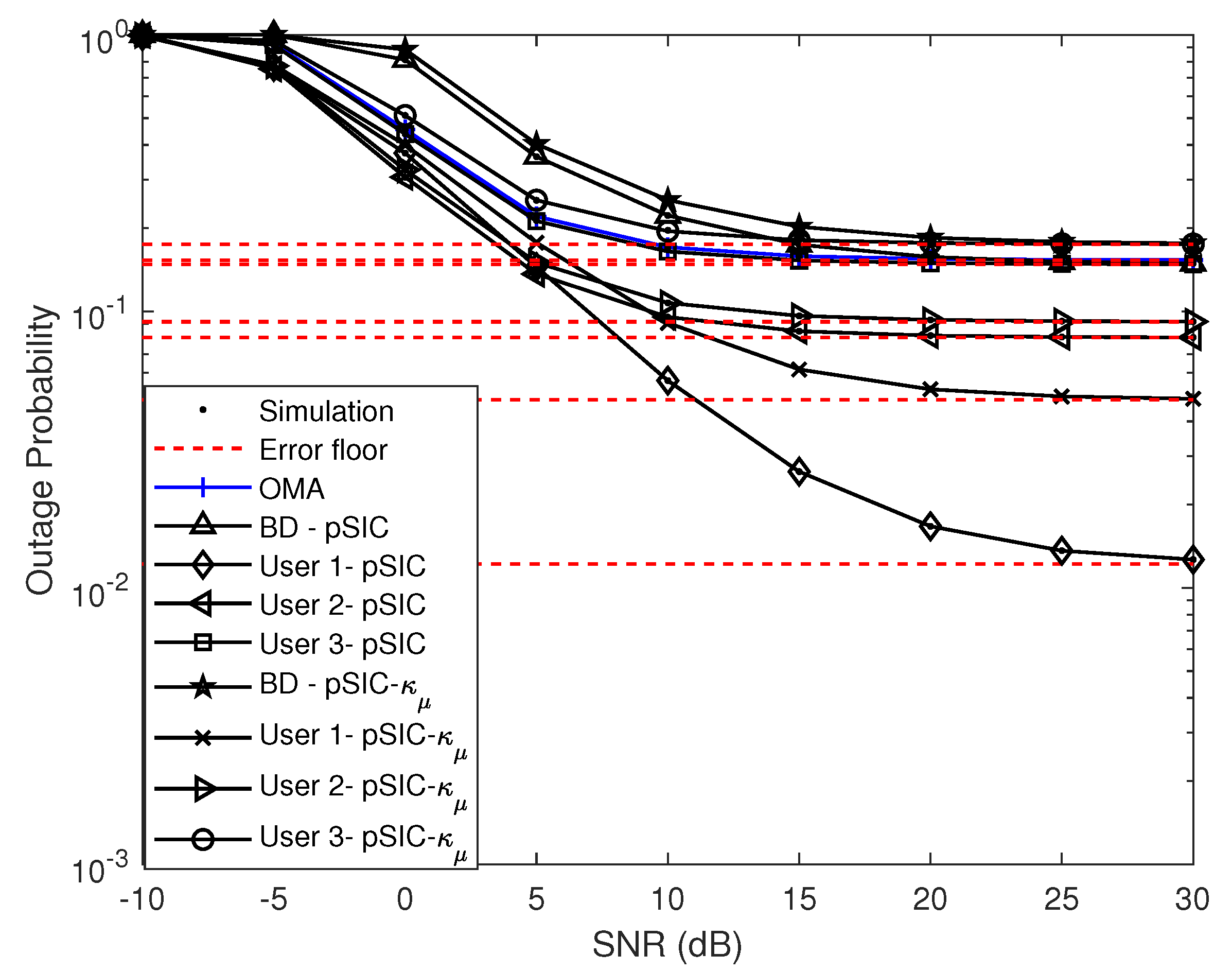
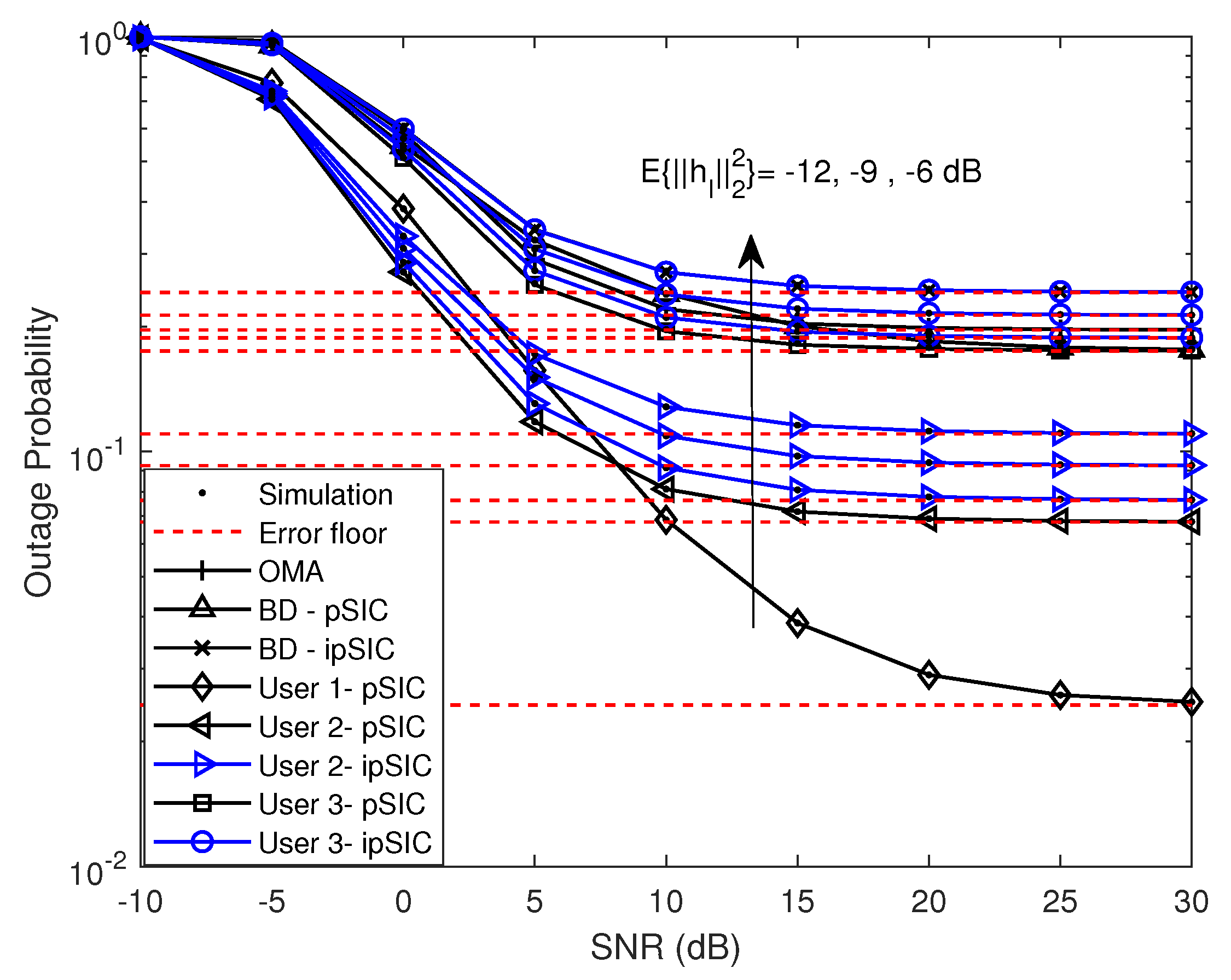
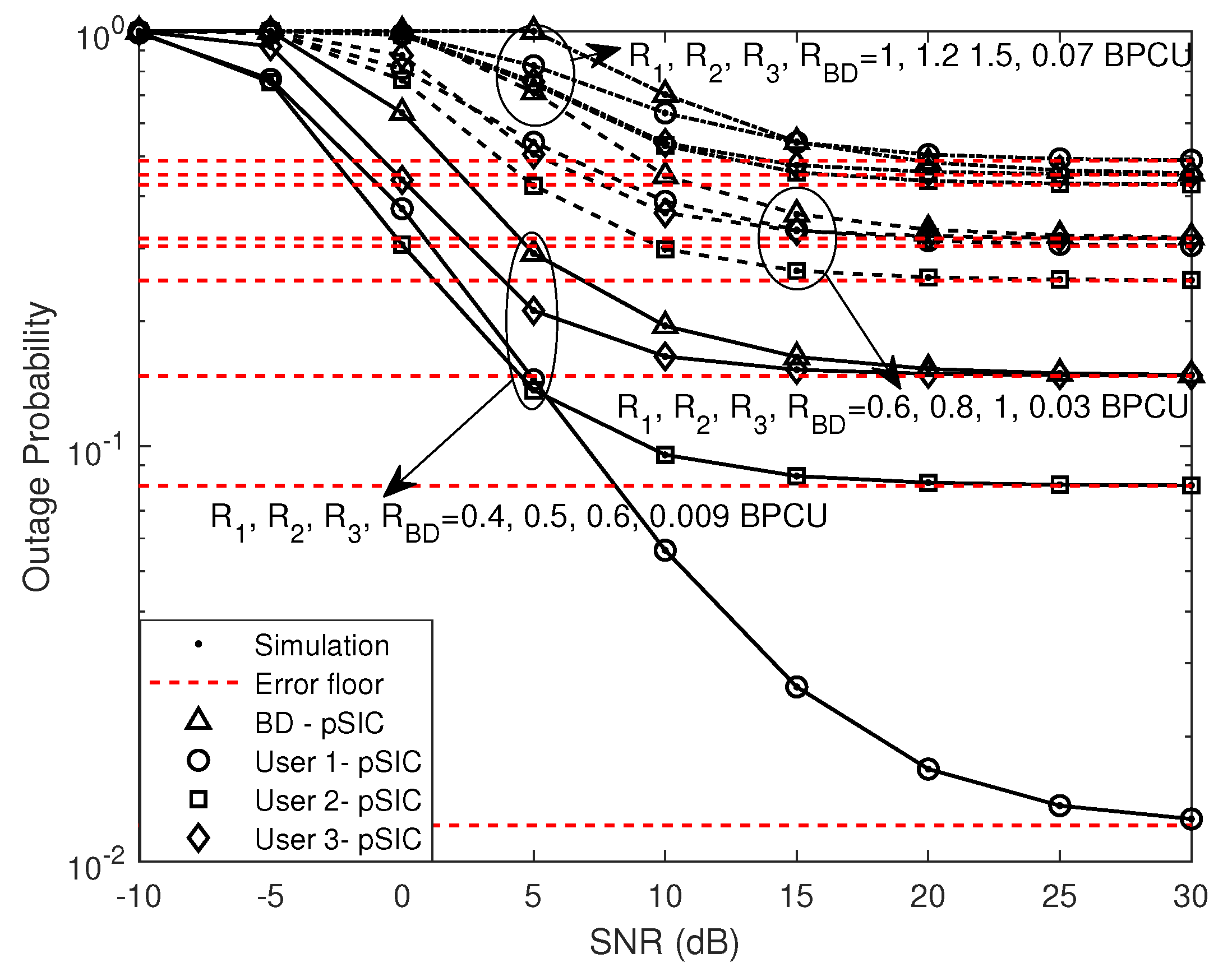

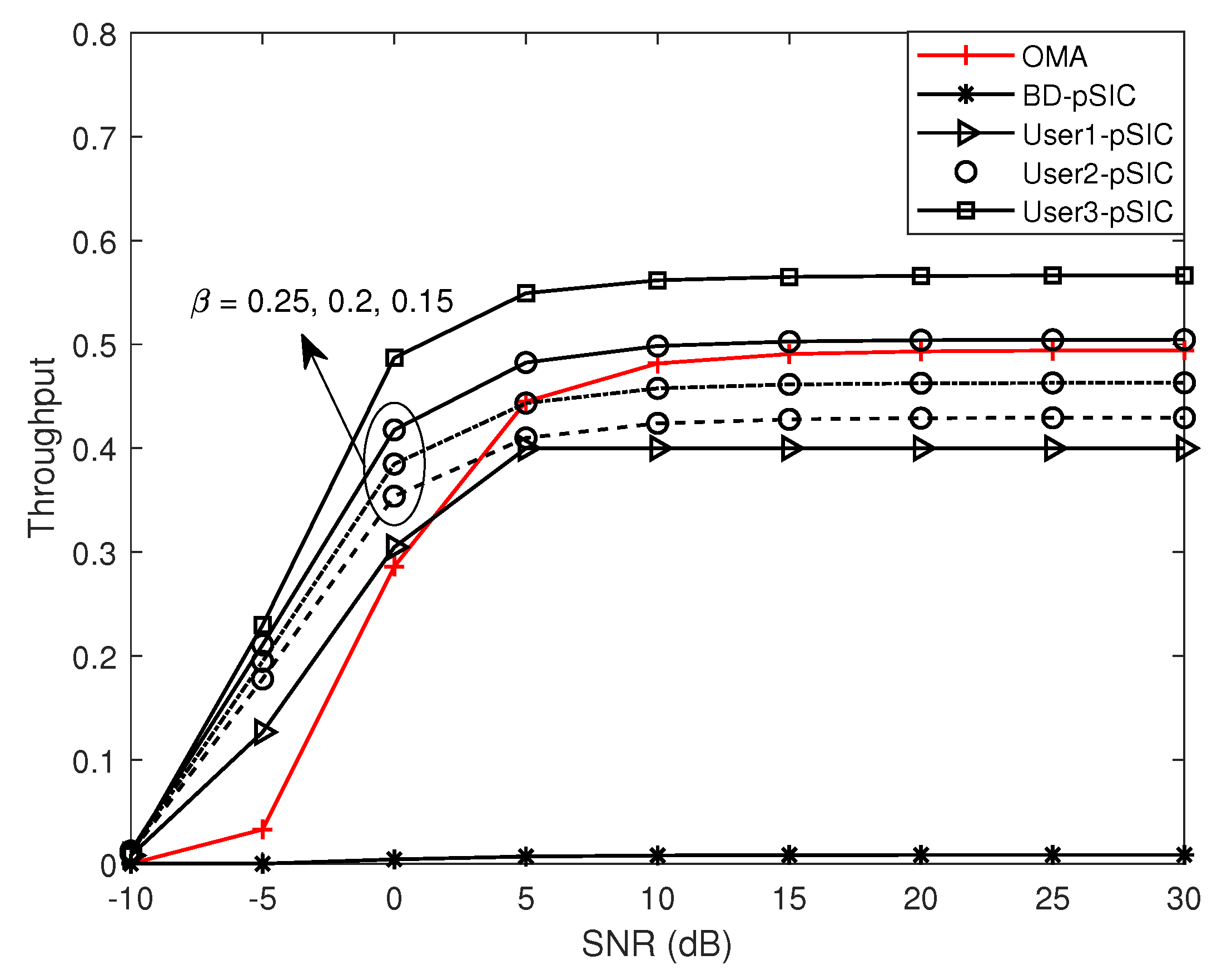
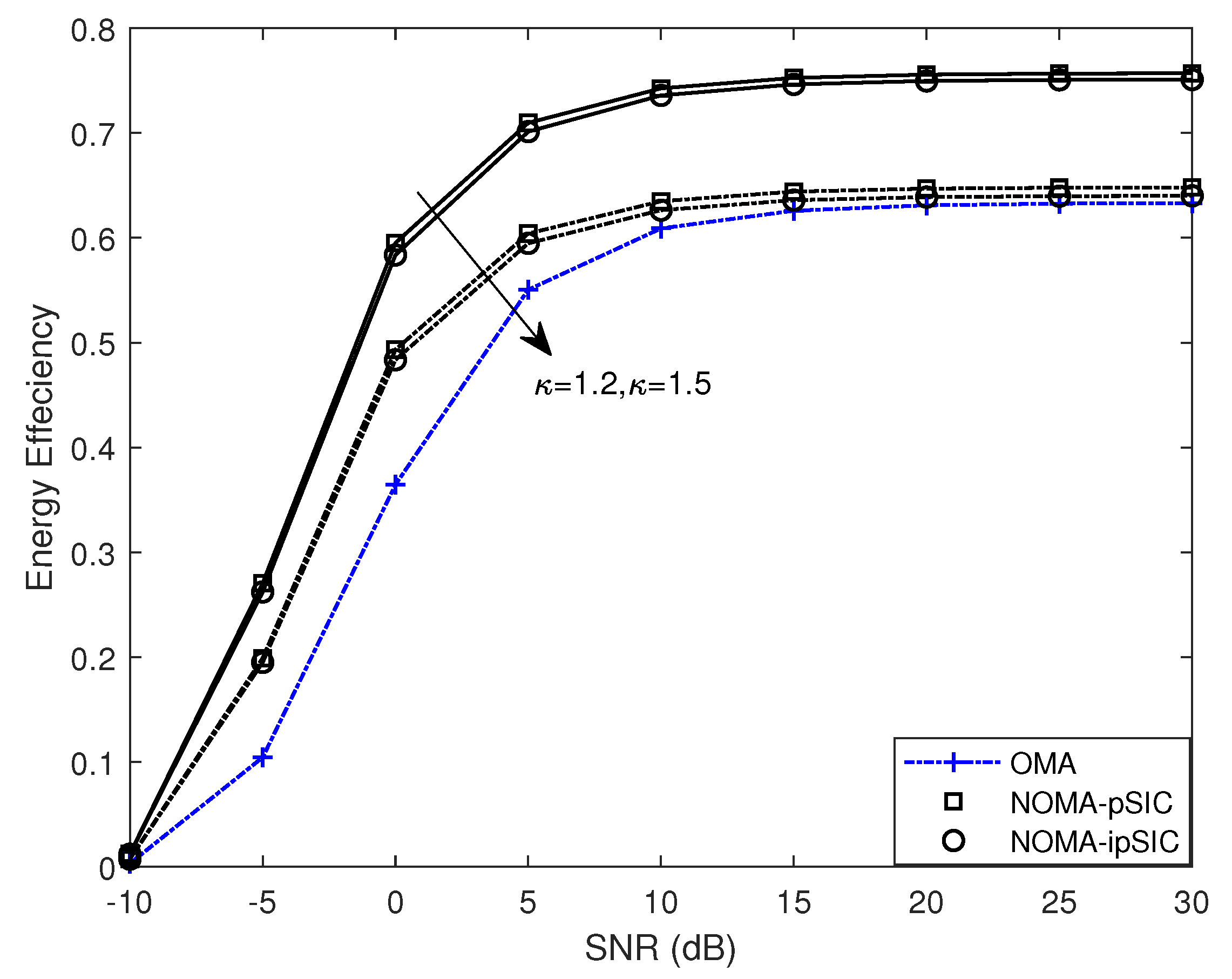
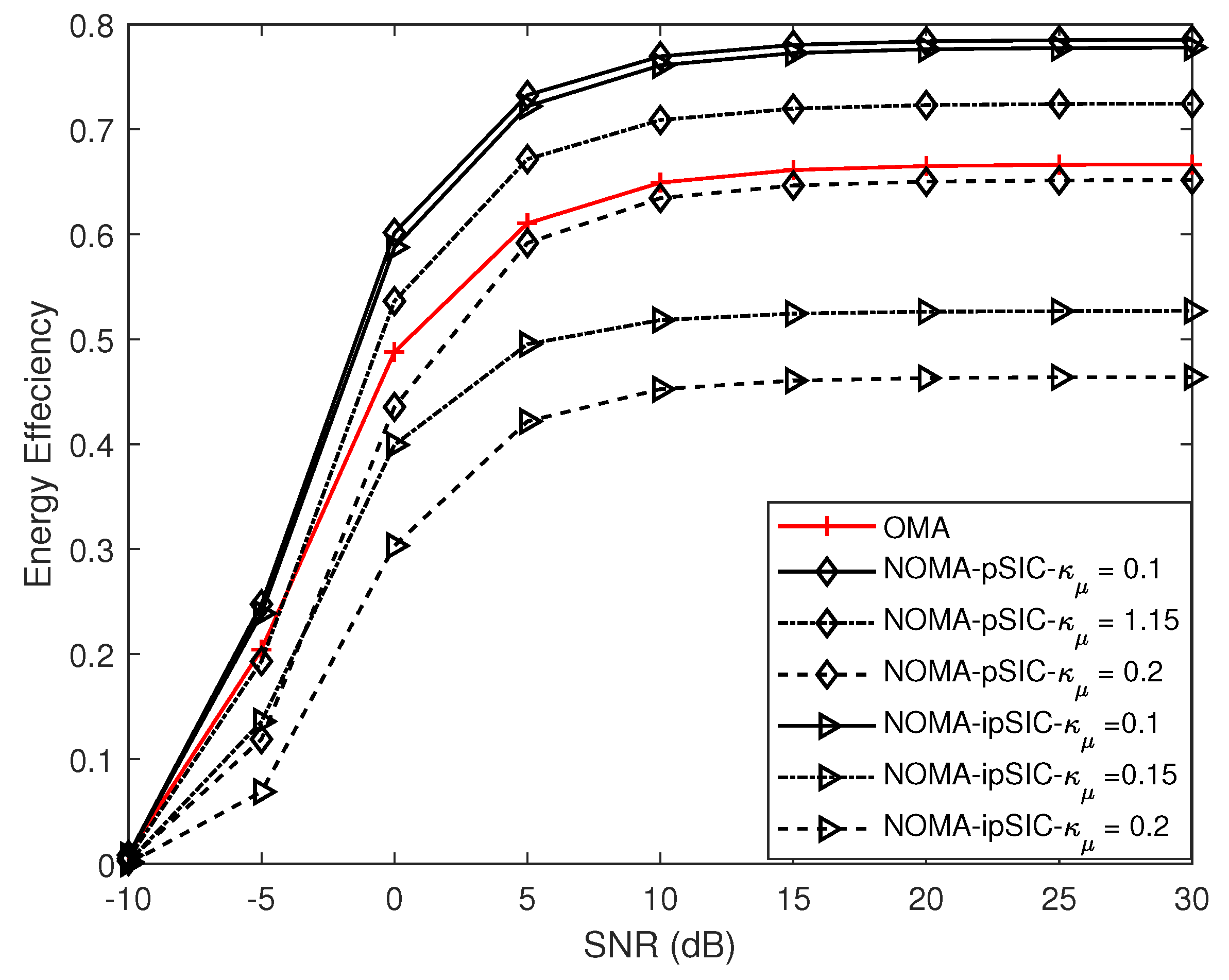
| Monte Carlo simulation of repeated values | iterations |
| Power distribution factor | |
| reflection coefficient | |
| RHIs parameter | |
| Gaussian white noise power | dB |
| ipSIC parameter | |
| Threshold data rates | BPCU |
| BPCU | |
| BPCU | |
| BPCU |
Disclaimer/Publisher’s Note: The statements, opinions and data contained in all publications are solely those of the individual author(s) and contributor(s) and not of MDPI and/or the editor(s). MDPI and/or the editor(s) disclaim responsibility for any injury to people or property resulting from any ideas, methods, instructions or products referred to in the content. |
© 2023 by the authors. Licensee MDPI, Basel, Switzerland. This article is an open access article distributed under the terms and conditions of the Creative Commons Attribution (CC BY) license (https://creativecommons.org/licenses/by/4.0/).
Share and Cite
Zhang, C.; Yue, X.; Yao, Y.; Li, X. Performance Analysis of Ambient Backscatter NOMA Systems. Appl. Sci. 2023, 13, 6166. https://doi.org/10.3390/app13106166
Zhang C, Yue X, Yao Y, Li X. Performance Analysis of Ambient Backscatter NOMA Systems. Applied Sciences. 2023; 13(10):6166. https://doi.org/10.3390/app13106166
Chicago/Turabian StyleZhang, Ce, Xinwei Yue, Yuanyuan Yao, and Xuehua Li. 2023. "Performance Analysis of Ambient Backscatter NOMA Systems" Applied Sciences 13, no. 10: 6166. https://doi.org/10.3390/app13106166






